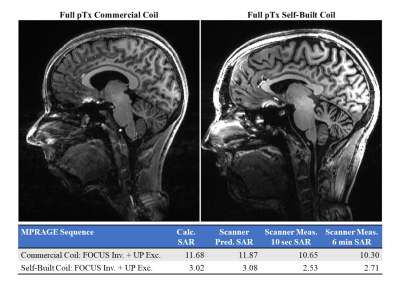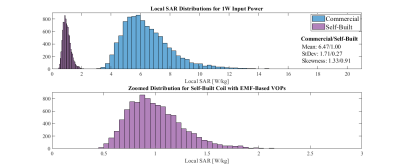Sydney Nicole Williams1, Jürgen Herrler2, Patrick Liebig3, Paul McElhinney1, Shajan Gunamony1,4, Armin M. Nagel5, and David A. Porter1
1Imaging Centre of Excellence, University of Glasgow, Glasgow, United Kingdom, 2Department of Neuroradiology, University Hospital Erlangen, Erlangen, Germany, 3Siemens Healthineers, Erlangen, Germany, 4MR CoilTech Limited, Glasgow, United Kingdom, 5Institute of Radiology, University Hospital Erlangen, Erlangen, Germany
1Imaging Centre of Excellence, University of Glasgow, Glasgow, United Kingdom, 2Department of Neuroradiology, University Hospital Erlangen, Erlangen, Germany, 3Siemens Healthineers, Erlangen, Germany, 4MR CoilTech Limited, Glasgow, United Kingdom, 5Institute of Radiology, University Hospital Erlangen, Erlangen, Germany
A comparison of local SAR in a commercial and self-built 8Tx/32Rx coil is made for pTx MPRAGE in healthy volunteers.The self-built coil uses virtual observation points (VOPs) derived from the coil model for SAR monitoring, yielding lower local SAR.

Figure 4. Comparison of full pTx MPRAGE (inversion and excitation) with the commercial coil (left) and self-built coil (right) for different subjects at different scanners. Both images were acquired with FOCUS inversion pulses and UP excitations designed for their respective coils and are windowed the same. The table lists calculated, scanner-predicted, and scanner-measured local SAR in W/kg. The image quality is comparable, but the estimated SAR is lower with the self-built coil and EMF-based VOPs.

Figure 2. Local SAR estimates for 10,000 random unit-norm shim configurations as well as CP and each VOP model’s “worst case”. Top row) local SAR distributions for the commercial coil with constant safety factor VOPs (blue) and the self-built coil with EMF-based VOPs (purple); the distribution mean, standard deviation, and skewness are listed as well. Bottom row) zoomed in distribution of self-built coil local SAR.
